Response to Climate Change
- Basic approach
- Metrics and goals
- Third-party verification of CO2 emissions data
- Compliance with TCFD
Basic approach
artience group recognized that responding to climate change is an important management issue that has a significant impact on corporate activities, and in November 2020, it expressed its support for the Task Force on Climate-related Financial Disclosures (TCFD). Based on the Group's Sustainability Vision ASV2050/2030, we are currently promoting climate change response activities, such as reducing CO2 emissions to achieve carbon neutrality in FY2050, and disclosing information in accordance with TCFD recommendations.
Metrics and goals
[Scope 1 and 2 Emissions] (Indicators for Risk)
In ASV2050/2030, we have set the long-term goal ASV2050 as the ideal state for 2050 to achieve carbon neutrality in the Group's production activities. In addition to the interim target ASV 2030, we have set the Group Materiality 2025-2030 target (KPIs and measures) to reduce global Scope 1+2 emissions by 26% compared to FY2020 by 2030.
To achieve these goals, we are taking various measures in three directions: reducing energy consumption, reducing energy carbon, and reducing the carbon of electricity. In Japan, where cogeneration systems are often operated at production sites, we will focus on reducing energy emissions, such as switching to low-carbon fuels used in systems and promoting the electrification of production facilities. While electrification of production facilities is progressing overseas, we will continue to promote the electrification of production facilities (e.g., LED lighting) and the reduction of electricity (e.g., the introduction of solar power generation equipment and the use of purchased electricity from renewable energy).
| Direction | Main measures |
|---|---|
| Reduce energy usage | ・Energy saving (Elimination of energy loss during the process) ・Reform of production processes from the perspective of energy conservation |
| Low carbon energy | ・Electrification of production equipment (reduction of direct emissions) ・Preparation and research for the use of LNG alternative fuels |
| Low-carbon electricity | ・Introduction of low-carbon electricity (reduction of indirect emissions) ・Introduction of renewable energy facilities |
Achievements
Scope 1 and 2 emissions
In FY2024, Scope 1 and 2 emissions were 152,002 tons (down 1.7% from the previous year) for the entire Group. The increase in Japan is due to changes in the emission factor, while the number of overseas decreases due to changes in the emission factor and the introduction of solar equipment.
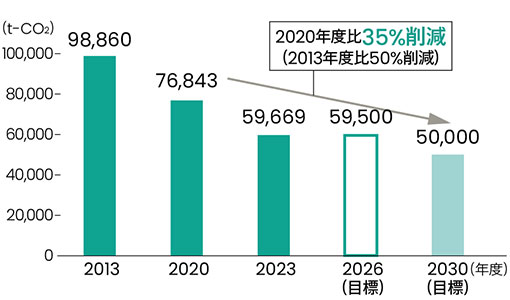
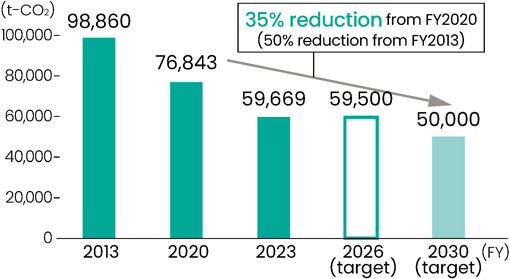
* Details of the calculation method and scope are described in the Environmental Data section
CO2 emissions in the supply chain (Scope 3)
CO2 emissions from business activities from upstream to downstream of the supply chain were calculated in accordance with the "Basic Guidelines for Calculating Greenhouse Gas Emissions through the Supply Chain."
Emissions from upstream and downstream of the supply chain (Scope 3) were calculated for 12 of the 15 categories indicated in the Basic Guidelines. For the processing, use, and disposal of the products sold (categories 10, 11, and 12), we did not calculate the entire scope of the calculation because the products are diverse and it is difficult to identify the processing, use, and disposal scenarios of the products we sold. In FY2024, we expanded the scope of aggregation by adding one overseas site to the calculation target. We will continue to improve the accuracy of aggregation and collaborate mainly through dialogue with suppliers to reduce CO2 emissions.
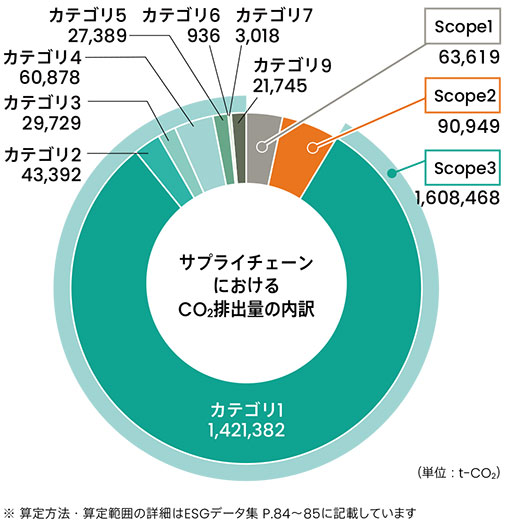
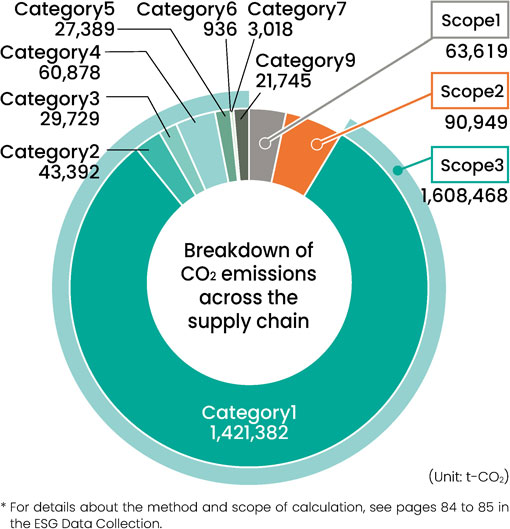
* Details of the calculation method and scope are described in the Environmental Data section
Energy usage
In FY2024, the Group's total was 72,859 kL (down 1.7% from the previous year), a decrease from the previous year in both Japan and overseas. Production increased, but energy use decreased due to energy conservation and product mix. Energy intensity (the amount of energy required to produce 1 ton of product) decreased slightly due to a decrease in utilization rates and changes in production items.
Third-party verification of CO2 emissions data
artience Co., Ltd. has undergone third-party verification of Scope 1 and 2 greenhouse gas (CO2) emissions for artience group (70% boundary) *.
Compliance with TCFD
In November 2020, we endorsed the TCFD (Task Force on Climate-related Financial Disclosures). We will enhance and accelerate our environmental initiatives, including measures to address climate change, and promote information disclosure in line with TCFD recommendations.
Information Disclosure Based on TCFD Recommendations
- Introduction of cogeneration system
- Implementation of Air Leakage Reduction Activities
- Renewable Energy Initiatives
- Climate Change Initiatives
Received the Energy Conservation Grand Prize
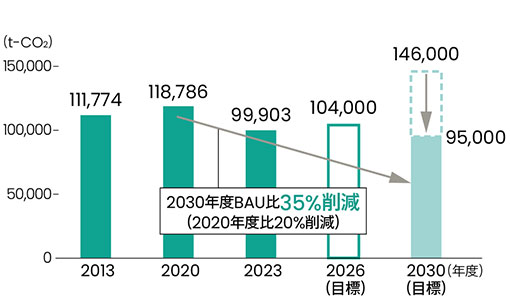
At the Saitama Plant, we used BI (Business Intelligence) tools to utilize buried data and established energy-saving activities through the participation of all employees. As a result of energy-saving activities, energy consumption (crude oil equivalent) and CO2 emissions at the Saitama Plant as a whole were reduced by 1,982 kL and 3,484 t-CO2 compared to FY2020, and energy intensity was improved by 13.4%.
These efforts and energy-saving achievements were evaluated, and the award was jointly awarded to artience Co., Ltd., TOYO INK Saitama Works, and TOYOCHEM Kawagoe Works.
- The Energy Conservation Award is sponsored by the Energy Conservation Center and recognizes outstanding energy-saving initiatives that serve as an example for others implemented by businesses and workplaces, as well as products and business models with excellent energy conservation
